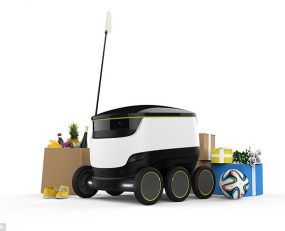
The share of grocery shopping conducted online continues to rise, particularly in the most advanced e-commerce markets such as the UK, South Korea and China. Globally, online grocery sales are forecasted to account for 20% of all grocery sales by 2025. However, while online grocery shopping is poised for strong growth over the next few years, it will require new technologies in order to develop.
This is due to the complexity of food logistics. The online grocery category is considerably more difficult than other e-commerce categories because there are more items per order and because customer expectations for short order-to-delivery cycles are very high. More importantly, when it comes to food logistics, the freshness of goods must be assured along the entire transport route, necessitating refrigeration. Such requirements add costs in a market where profit margins are already tight.
This has not, however, deterred many established companies, new entrants and start-ups to venture into e-grocery delivery. The main players in the tech-driven food delivery market have been ‘unicorns’ such as Instacart and Delivery Hero. Considering that grocery is one of the most obvious product categories for which instant delivery is required, it is no surprise that there has been a lot of start-up activity in the e-grocery delivery market. Over the past five years, start-ups in this field have attracted funding just short of $10bn, according to the consultancy firm McKinsey. Considering the positive growth forecasts for the e-grocery market, it is likely that, moving forward, food delivery will continue to receive a lot of attention from investors.
Despite the growing demand for this type of service and the significant injections of funds into grocery logistics, it has been a bumpy ride for most of the companies operating on this market. A number of start-ups have failed trying to succeed in the market and even Amazon, which has been investing heavily in expanding its delivery network, has not quite mastered the art of profitably delivering perishable food.
In this respect, there are a number of innovations that logistics companies can count on to fulfil high volume of orders. These are mainly targeted at last-mile logistics which is a particularly complicated area for online grocery orders due to the specific temperature requirements. They include ground-based delivery drones and robots which eliminate labour costs and which are being increasingly adopted by retailers. In May this year, Tesco successfully trialled robot deliveries in central London after linking up with Starship Technologies. Another area in which emerging technologies can make food logistics more efficient is fulfilment, which has seen some major developments. Notably, the UK-based grocery e-retailer Ocado opened a warehouse last year which is largely automated and with an inventory management system driven by Artificial Intelligence.
Finally, it should be noted that in addition to the complexity inherent in the delivery of perishable food, the crowded space in the market has also contributed to many of the failures in the market. Therefore, the only way for grocery start-ups to remain profitable moving forward is to scale in a massive way. And if e-grocery retail continues to grow, retailers will find it more difficult to keep the logistics services in-house, which could ultimately prompt them to outsource this service, thus providing start-ups with scalability opportunities.
Source: Transport Intelligence, July 27, 2017
Author: Violeta Keckarovska
Ti’s Global e-commerce Logistics 2017 report provides market analysis first from an industry-wide perspective, and then delves further to examine the supply chains of major e-retailers and the logistics providers which support them. The report includes Ti’s bespoke market size and forecasts at a global, regional and country level in addition to data and analysis of e-commerce logistics costs as a % of sales for 20 online retailers.